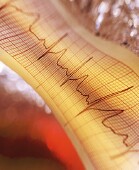- Tips for Spending Holiday Time With Family Members Who Live with Dementia
- Tainted Cucumbers Now Linked to 100 Salmonella Cases in 23 States
- Check Your Pantry, Lay’s Classic Potato Chips Recalled Due to Milk Allergy Risk
- Norovirus Sickens Hundreds on Three Cruise Ships: CDC
- Not Just Blabber: What Baby’s First Vocalizations and Coos Can Tell Us
- What’s the Link Between Memory Problems and Sexism?
- Supreme Court to Decide on South Carolina’s Bid to Cut Funding for Planned Parenthood
- Antibiotics Do Not Increase Risks for Cognitive Decline, Dementia in Older Adults, New Data Says
- A New Way to Treat Sjögren’s Disease? Researchers Are Hopeful
- Some Abortion Pill Users Surprised By Pain, Study Says
World’s Tiniest Pacemaker Seems Safe, Effective in Trial


The world’s smallest pacemaker is safe and effective in patients with a slow heart rhythm, according to the first human clinical trial of the device.
A permanent pacemaker is the only effective treatment for slow heart rhythm. This new miniaturized pacemaker — called the Micra transcatheter pacing system — is implanted through the femoral vein (running from the leg to the heart) and placed directly inside the heart’s right ventricle.
According to a news release from the Heart Rhythm Society, the new device is tiny: 93 percent smaller than conventional transvenous pacemakers. It also reduces complication risks, the news release said, because it does not use leads or require a chest pocket.
This new study was led by Dr. Philippe Ritter, of the Hospital Haut-Leveque in Bordeaux, France, and included the first 60 patients to receive the pacemaker. The team reported that it took an average of 37 minutes to implant the pacemaker, and at one and three months after implantation all electrical measurements were within expected ranges.
Serious adverse events occurred in 5.7 percent of patients, which is comparable to other pacemakers, the researchers said. There were no deaths.
Based on data gathered so far, the estimated lifespan of the device is about 10 years, according to the study to be presented Friday at the Heart Rhythm Society’s annual meeting, in Boston.
“The results of this study are very promising and we have seen firsthand how the device size and minimally invasive procedure truly can improve the quality of life for patients,” Ritter said in the news release.
“The new miniaturized pacemaker not only eliminates many of the traditional complications associated with conventional transvenous pacing, but it also has the potential to advance patient care and set a new standard for single chamber pacemakers,” he added.
Two cardiologists in the United States called the device a potential advance.
“Leadless pacemakers are a new technology that eliminate the weakest link in currently available pacemaker systems — namely the lead, or the wire that goes from the heart to the pacemaker generator that is placed in a pocket in the chest wall,” said Dr. Nicholas Skipitaris, director of cardiac electrophysiology at Lenox Hill Hospital in New York City.
“This study shows that leadless pacemakers are safe and function appropriately to treat patients with slow heart rhythms,” he added. “This groundbreaking technology represents a significant advance in the field of permanent pacing and will improve patient care.”
Dr. Vivek Reddy directs arrhythmia services at the Mount Sinai Hospital and Mount Sinai Health System in New York City. He called the new pacemaker “a great step forward,” although he said longer-term study is needed.
According to the French team, the clinical trial will continue to assess the long-term safety and benefits of the miniaturized pacemaker.
Experts note that findings presented at medical meetings are typically considered preliminary until published in a peer-reviewed journal.
More information
The U.S. National Heart, Lung, and Blood Institute has more about pacemakers.
Source: HealthDay
Copyright © 2024 HealthDay. All rights reserved.










